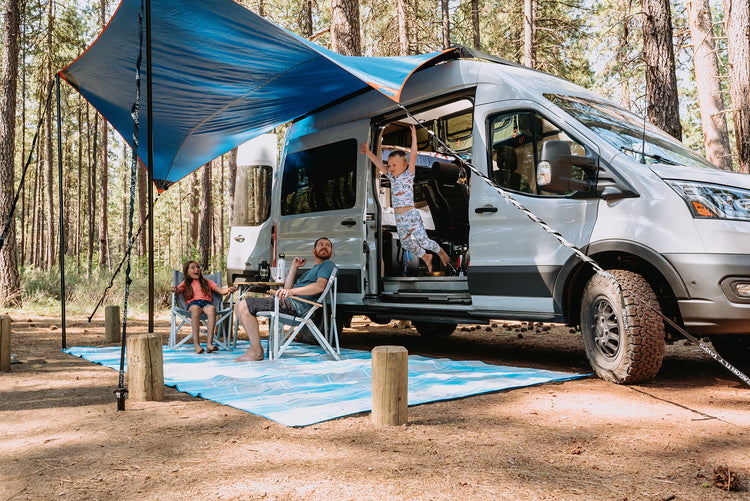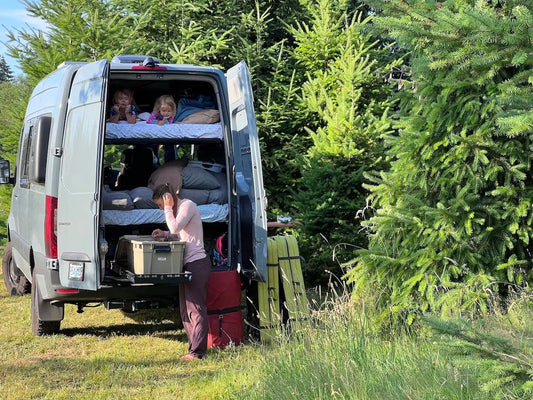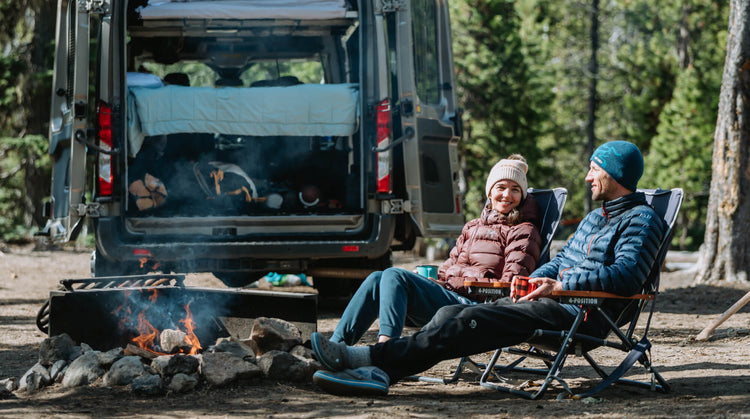Van awnings provide shade, protection from the rain, and with the addition of a ground cover like a Cgear Sand-free Mat, they're a great way to create a clean, functional, covered space.
If you’re wondering what type of awning to buy for your van, we’ve got you covered. There are three main types of awnings that we’ll discuss in this article: tarps, traditional, and batwing. Spoiler alert: we love Dragonfly tarps and offer AdWag branded versions on our website, but there are pros and cons to each type. Read on as we discuss awnings and hopefully help you along your journey!
Tarp Awnings
There are several tarp options out there ranging from the full DIY Home Depot paracord version to the burley Dragonfly Tarps we mentioned before. Many higher end tarps use a track system where the tarp slides into a track that’s adhered/screwed to the van or roof rack. From there the tarp is set up using poles and stakes. In this article, we’ll be focusing on the Dragonfly Haku due to our familiarity with the product, their popularity in the van industry, and the fact the Haku is one of the few options specifically made for high roof camper vans.

The Dragonfly Haku attaches to the van via a low-profile track and is propped up by two collapsable poles. It then uses ultra-tough nylon webbing with cam buckles and stakes to secure it in place.

What we like about them
Durability, versatility, coverage, and minimalism. The Dragonfly Haku can withstand much stronger winds than traditional and batwing awnings, which is the first measure of durability. The Haku is beautifully simple, made of thick ripstop material with no hinges or mechanical systems to fail. But even if a fierce wind should rip the massive stakes from the ground like something out of the movie Twister, a tarp is usually recoverable, whereas an aluminum frame awning ends up becoming a mess of twisted metal.
The Haku shines when it comes to coverage – about 18x10 feet total. We don’t mean to throw shade at other awnings, but that kind of coverage is hard to beat, especially in a lightweight package. Beyond the large space, it’s versatile, allowing you to change angles to protect from the elements, and can even be set up as a stand-alone shelter unattached from your van. It's one of those rare items that’s minimalist yet provides ample durability and protection. The minimalism and versatility align perfectly with the AdWag ethos – If you’re hauling plywood or moving a couch, you probably don’t need an awning. So rather than have a bulky 40+ pound awning bolted to your van, the Dragonfly virtually disappears when not in use.
 The Haku provides a significant sheltered area
The Haku provides a significant sheltered area
What could be better
The Dragonfly takes a bit more time to set up when compared to traditional or batwing awnings, particularly if you don’t take the time to line and stake down the latter. If you have the routine down and have a helper, setting up the Haku can be done in 5-10 minutes.
Because the lines need to be staked in the ground, tarps cannot be deployed on concrete or solid rock without some additional weighted objects to attached to, or a jackhammer. So, if you’re frequently on the move and looking to deploy your awning at every stop, or often camping on asphalt surfaces, a tarp style awning may not be for you.
Traditional Awnings
Traditional awnings are ubiquitous in the trailer and RV world. They generally attach to the side/roof of your rig in a rigid (aluminum) or soft storage case and have either a manual crank or motorized mechanism that deploys the awning. Some are also straight pull, like a projector screen. Leg posts either go to the ground or attach to the side of the van, the latter generally requiring screws in the van body. Popular brands like Fiamma and Thule dominate this market, although there are countless other companies that make their own variations.
Note: If you have a high roof van and the posts are going to the ground, make sure they’re long enough to touch the ground!
 The Fiamma F45 and F40 awnings are popular choices for camper vans. Photo from flatlinevanco.com
The Fiamma F45 and F40 awnings are popular choices for camper vans. Photo from flatlinevanco.com
What we like about them
The best things about traditional awnings are that they’re easy to deploy and can be used on any surface. Set up generally takes a few minutes and can often be done with one person. They store outside the van (which, as we’ll discuss, has its pros and cons) so they don’t take up cargo space inside. There’s also a wide variety of brands, price ranges, sizes, and colors to choose from.
What could be better
When the weather rolls in, it’s time to roll it up. Wind is not the friend of the traditional awning, and although some give you the option to add security in the form of guylines, the hinges and aluminum are simply too susceptible to anything beyond a light wind. Because they’re generally fastened to your van body or roof rack, there’s also potential for damage beyond just the awning if the wind hits hard enough.
Beyond their fragile nature, traditional awnings have limited versatility. If the sun or rain is coming in at an angle, there’s little you can do to adjust for it, although some do have optional side walls. Generally, manual crank awnings will allow for more versatility when it comes to angling out the elements than mechanical awnings, which is key when you have a tall van. As mentioned, these are attached to the outside of your vehicle, which saves space in the van, but also leaves it susceptible to damage from tree branches, etc., if you ever drive in tight spaces. They can also limit what type of roof rack you can use. Most are bolted on, so the awning is along for the ride whether you need it or not.
Batwing Style Awnings
Unlike traditional awnings which are seen on just about every RV and trailer, the batwing style is more popular with the overlanding crowd. These can often be found on pick-up trucks, Jeeps and SUVs outfitted for remote journeys off the beaten path. Like traditional awnings, batwings generally attach to your roof rack or directly to your rig and rely on aluminum support arms. It’s really the mechanism and movement of these supports, fanning out rather than cranking outward away from the van, that differentiate batwing and traditional awnings. The shape creates more space along the vehicle and can even wrap all the way to the back, which results in a larger covered outdoor area.
Note: If you have a high roof van and the leg posts are going to the ground, make sure they’re long enough to touch the ground!

Batwing awnings like the OVS Nomadic 180 are popular among overlanding enthusiasts. Photo from thewaywardhome.com
What we like about them
They tend to be a bit more burley than traditional awnings, which is possibly why they’re more popular for rugged overlanding vehicles, and as mentioned, they often provide more coverage. Beyond that, most of the same principles apply. Most are easy to set up and can be deployed anywhere (even without support posts in mild weather), and while not quite as ubiquitous as their traditional counterparts, batwing awnings can be found in a variety of styles by many different manufacturers such as 23ZERO and Overland Vehicle Systems.
What could be better
While generally more stout than traditional awnings, they’re still susceptible to wind damage. There’s only so much you can do with what can essentially amount to a sail with rigid aluminum arms. Because they tend to stick straight out, it can be difficult to block out the sun on a high roof van when the exposure is anywhere on the passenger side, and because of its rigid nature, the angle cannot be adjusted (note: on some models you can purchase add-on “wall kits” to create a more complete shelter with better shade). They can also be a pain to stuff back into their soft storage bag and get it zipped up, particularly with a high roof vehicle.
Which awning is right for you?
Like any decision regarding van gear, you must consider the type activities you do most frequently. If you’re often in ski resort parking lots and like to use an awning when the weather allows, or you’re a fair-weather camper frequently moving from one campground to another and an awning is a must, then traditional or batwing style may be the right call. If you’re into camping or overlanding, want excellent coverage and aren’t afraid of a bit of foul weather, a quality tarp setup is likely what you’ll want. Either way, we hope this article helped you along your journey. Happy Trails!





